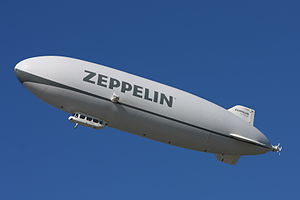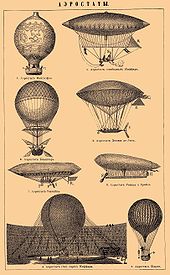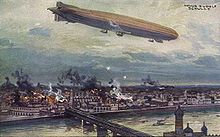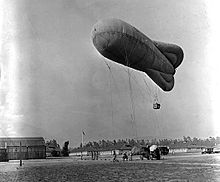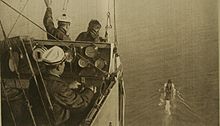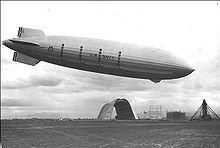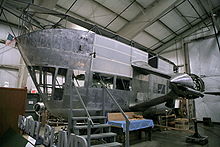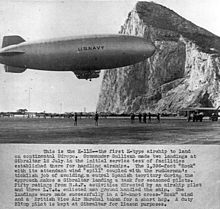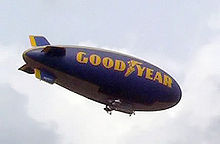- Airship
-
For other uses, see Airship (disambiguation)."Dirigible" redirects here. For the 1931 film, see Dirigible (film).Not to be confused with Balloon (aircraft) or Blimp.
Airship A modern airship Part of a series on
Categories of aircraftSupported by lighter-than-air gases (aerostats) Unpowered Powered - Airship
Supported by LTA gases + aerodynamic lift Unpowered Powered - Hybrid moored balloon
- Kytoon
Supported by aerodynamic lift (aerodynes) Unpowered Powered Unpowered fixed-wing Powered fixed-wing - Glider
- Hang gliders
- Paraglider
- Kite
- Airplane (aeroplane)
- Powered paraglider
- Flettner airplane
- Ground-effect vehicle
Powered hybrid fixed/rotary wing Unpowered rotary-wing Powered rotary-wing - Autogyro
- Gyrodyne ("Heliplane")
- Helicopter
Powered aircraft driven by flapping Other means of lift Unpowered Powered An airship or dirigible is a type of aerostat or "lighter-than-air aircraft" that can be steered and propelled through the air using rudders and propellers or other thrust mechanisms. Unlike aerodynamic aircraft such as fixed-wing aircraft and helicopters, which produce lift by moving a wing through the air, aerostatic aircraft stay aloft by having a large "envelope" filled with a gas which is less dense than the surrounding atmosphere. The first lifting gas used was hydrogen, although this had well-known concerns over its flammability. Where helium was available, which was only in the USA, this non-flammable gas was used instead. All modern airships, since the 1960s, use helium.[note 1]
The main types of airship are non-rigid (or blimps), semi-rigid and rigid. Blimps are "pressure" airships where internal pressure, maintained by forcing air into internal ballonet, is used to both maintain the shape of the airship and its structural integrity. Semi-rigid airships maintain the envelope shape by internal pressure, but have some form of internal support such as a fixed keel to which control and engine gondolas and stabilizers and steering surfaces are mounted. Rigid airships have structural skeletons which maintain the shape and carry all loads from gondolas, engines, control surfaces and stabilizers. The skeleton contains numerous balloons, known as "gas cells" which supply the static lift without having to bear any structural loading.[1] The name Zeppelin as the type was invented by Count Zeppelin and the vast majority of rigid airships built were manufactured by the firm he founded.
Airships were the first aircraft to enable controlled, powered flight, and were widely used before the 1940s, but their use decreased over time as their capabilities were surpassed by those of airplanes. Their decline continued with a series of high-profile accidents, including the 1937 burning of the hydrogen-filled Hindenburg near Lakehurst, New Jersey, and the destruction of the USS Akron. Airships are still used today in certain niche applications, such as advertising, freight transportation, tourism, camera platforms for sporting events, aerial observation and interdiction platforms, where the ability to hover in one place for an extended period outweighs the need for speed and maneuverability.
Contents
Terminology
Aerostat
There is some confusion around the term aerostat with regard to airships. This confusion arises because aerostat has two different meanings. One meaning of aerostat refers to all craft that remain aloft using buoyancy (static not dynamic lift): in this sense airships are a type of aerostat. The narrower and more technical meaning of aerostat refers only to tethered or moored balloons: in this sense airships are not aerostats.
Dirigible
In some countries, airships are also known as dirigibles from the French (diriger to direct plus -ible), meaning "directable" or steerable. The first airships were called dirigible balloons. Over time, the word balloon was dropped from the phrase. In modern usage, balloon refers to any buoyant aircraft that generally relies on wind currents for horizontal movement, and usually has a mechanism to control vertical movement.
Gondola
The term "gondola" is used to describe the passenger/instrument and/or engine area of an airship. There may be one or more.[citation needed]
Zeppelin
The term zeppelin is a genericised trademark that originally referred to airships manufactured by the German Zeppelin Company, which pioneered dirigible design in the early years of the twentieth century. The word Luftschiff, German for "airship", usually prefixed their crafts' names.
In modern common usage, the terms Zeppelin, dirigible and airship are used interchangeably for any type of rigid airship, with the term blimp alone used to describe non-rigid airships. Although the blimp also qualifies as a "dirigible", the term is seldom used with blimps. In modern technical usage, airship is the term used for all aircraft of this type, with Zeppelin referring only to aircraft of that manufacture, and blimp referring only to non-rigid airships.[clarification needed]
Twin Balloons Airship
On October 22, 2011 the Twin Balloons Airship is made by JP Aerospace has flown to 95,085 feet as the New Airship World Altitude Record. The unmanned tandem airship flew nearly 4 miles higher than any airship before is provided with 2 electric motors each spin a propeller.[2]
Types
- Non-rigid airships (blimps) use a pressure level in excess of the surrounding air pressure to retain their shape during flight. Unlike the rigid design, the non-rigid airship's gas envelope has no compartments. At sea level, the ballonets (internal flexible cells) are filled with air. As altitude is increased, the lifting gas expands and air from the ballonets is expelled through air valves to maintain the same hull shape. To return to sea level, the process is reversed. Air is forced back into the ballonets by both scooping air from the engine exhaust and using auxiliary blowers.
- Semi-rigid airships, like blimps, require internal pressure to maintain their shape, but have extended, usually articulated keel frames running along the bottom of the envelope to distribute suspension loads into the envelope and allow lower envelope pressures.
- Rigid airships (Zeppelin is almost synonymous with this type) have rigid frames containing multiple, non-pressurized gas cells or balloons to provide lift. Rigid airships do not depend on internal pressure to maintain their shape and can be made to virtually any size.
- Metal-clad airships were of two kinds: rigid and non-rigid. Each kind used a thin gastight metal envelope, rather than the usual rubber-coated fabric envelope. Only four metal-clad ships are known to have been built, and only two actually flew: Schwarz's first aluminum rigid airship of 1893 collapsed,[3] while his second flew;[4] the non-rigid ZMC-2 flew 1929 to 1941;[5] while the 1929 non-rigid Slate City of Glendale collapsed on its first flight attempt.[6][7][8]
- Thermal airships use a heated lifting gas, usually air, in a fashion similar to hot air balloons.
History
Early pioneers
 Crossing of the English Channel by Blanchard in 1785.
Crossing of the English Channel by Blanchard in 1785.
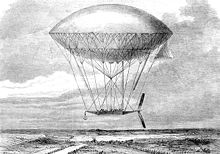 The navigable balloon developed by Henri Dupuy de Lôme in 1872.
The navigable balloon developed by Henri Dupuy de Lôme in 1872.
Francesco Lana de Terzi is referred to as the "Father of Aeronautics"[9] in part for his theoretical design of a Vacuum airship circa 1670. Structural limitations have prevented this concept from taking flight.[10]
The father of the dirigible was Lieutenant Jean Baptiste Marie Meusnier (1754–93). On 3 December 1783, he presented an historic paper to the French Academy: "Mémoire sur l’équilibre des machines aérostatiques" (Memorandum on the equilibrium of aerostatic machines). The 16 water-colour drawings published the following year depicted a 260-foot-long (79 m) envelope with internal ballonnets that could be used for regulating lift, and this was attached to a long carriage that could be used as a boat if the vehicle was forced to land in water. The airship was designed to be propelled in the air by three airscrew propellers and steered with a sail-like aft rudder. In 1784, Jean-Pierre Blanchard fitted a hand-powered propeller to a balloon, the first recorded means of propulsion carried aloft. In 1785, he crossed the English Channel with a balloon equipped with flapping wings for propulsion, and a bird-like tail for steerage.[11]
The 19th century saw continued attempts at adding propulsion to balloons. The first aviation pioneer of Australia was Dr William Bland, a naval surgeon who was sentenced to seven years transportation in a Calcutta court after a duel in Bombay in 1813. In March 1851, Bland sent designs for his "Atmotic Airship" to the Great Exhibition at the Crystal Palace in London where a model was displayed. His idea was to supply power to an elongated balloon with a steam engine installed in a car, Since the lift of the balloon was estimated at 5 tons and the car with the fuel weighed 3.5 tons, the payload was estimated at 1.5 tons. Bland believed that with two airscrews the machine could be driven at 80 km/h (50 mph) and could fly from Sydney to London in less than a week. The first person to make an engine-powered flight was Henri Giffard who, in 1852, flew 27 km (17 mi) in a steam-powered airship.[12] Airships would develop considerably over the next two decades: there were reports that on 1 June 1863 Dr. Solomon Andrews had launched the Aereon comprising two horizontal cylindrical gas bags with no motor that "wheeled gracefully and headed back towards them" and that later, pilotless after Andrews had released all ballast, flew in "ascending spirals" and during this ascent that it "was apparent to everyone that the ship was moving with the wind and then against it" with a Herald reporter estimating the speed at 120 mph.[13] In 1872, the French naval architect Dupuy de Lome launched a large limited navigable balloon, which was driven by a large propeller and the power of eight people.[14] It was developed during the Franco-Prussian war, as an improvement to the balloons used for communications between Paris and the countryside during the Siege of Paris by German forces, but was completed only after the end of the war.
Paul Haenlein flew an airship with an internal combustion engine running on the coal gas used to inflate the envelope over Vienna, the first use of such an engine to power an aircraft in 1872.[15][16] Charles F. Ritchel made a public demonstration flight in 1878 of his hand-powered one-man rigid airship, and went on to build and sell five of his aircraft.[16]
In the 1880s a Serb named Ogneslav Kostovic Stepanovic also designed and built an airship. However, the craft was destroyed by fire before it flew. In 1883, the first electric-powered flight was made by Gaston Tissandier who fitted a 1.5 hp (1.1 kW) Siemens electric motor to an airship. The first fully controllable free-flight was made in a French Army airship, La France, by Charles Renard and Arthur Constantin Krebs in 1884. The 170 ft (52 m) long, 66,000 cu ft (1,900 m3) airship covered 8 km (5.0 mi) in 23 minutes with the aid of an 8.5 hp (6.3 kW) electric motor,[17] and a 435 kilograms (960 lb) battery. In 1884 and 1885, it made seven flights.[16]
In 1888, the Novelty Air Ship Company made the Air Ship for Professor Peter C. Campbell which was known as the Campbell Air Ship. The air ship was lost at sea in 1889 while being flown by Professor Hogan during an exhibition Flight.[18]
In 1888–97, Dr. Frederich Wölfert built three airships powered by Daimler Motoren Gesellschaft-built petrol engines, the last of which caught fire in flight and killed both occupants in 1897.[19] The 1888 version used a 2 hp one cylinder Daimler engine and flew 10 km (6 mi) from Canstatt to Kornwestheim.[20][21]
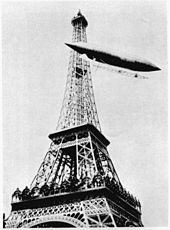 Santos-Dumont#6 rounding the Eiffel Tower, winning the Deutsch Prize in 1901.
Santos-Dumont#6 rounding the Eiffel Tower, winning the Deutsch Prize in 1901.
In 1897, a rigid airship created by the Hungarian[22] engineer David Schwarz and further modified after his death, made its first flight at Tempelhof field in Berlin. After Schwarz's death, his wife, Melanie Schwarz, was paid 15,000 marks by Count Ferdinand von Zeppelin for information about the airship.[23][clarification needed]
A wealthy Brazilian who lived in France, Alberto Santos-Dumont had a passion for flying. He designed 18 examples of balloons and dirigibles, and created 18 different examples of the latter before turning his attention to fixed winged aircraft.[24] In 1901, in his airship Number 6, a small blimp, he won the Deutsch de la Meurthe prize of 100,000 francs for flying from the Parc Saint Cloud to the Eiffel Tower and back in under thirty minutes.[25] Many inventors were inspired by Santos-Dumont's small airships and a veritable airship craze began worldwide. The well-known aeronaut Stanley Spencer claimed he had "out Santosed" Santos referring to his own 1902 flight from Crystal Palace to Harrow.[26][27] Many airship pioneers, such as the American Thomas Scott Baldwin financed their activities through passenger flights and public demonstration flights. Others, such as Walter Wellman and Melvin Vaniman set their sights on loftier goals, attempting two polar flights in 1907 and 1909, and two trans-atlantic flights in 1910 and 1912.[28]
"The Golden Age"
The "Golden Age of Airships" began in July 1900 with the launch of the Luftschiff Zeppelin LZ1. This led to the most successful airships of all time: the Zeppelins. These were named after Count von Zeppelin who began experimenting with rigid airship designs in the 1890s leading to the badly flawed LZ1 (1900) and the more successful LZ2 (1906). At the beginning of World War I the Zeppelin airships had a framework composed of triangular lattice girders, covered with fabric and containing separate gas cells. Multi-plane, later cruciform, tail fins were used for control and stability, and two engine/crew cars hung beneath the hull driving propellers attached to the sides of the frame by means of long drive shafts. Additionally, there was a passenger compartment (later a bomb bay) located halfway between the two cars.
Other airship builders were also active before the war: The French company Lebaudy Frères specialised in semi-rigid airships from 1902 (e.g. the Patrie and the République), designed by their engineer Henri Julliot, who later worked for the American company Goodrich; the German firm Schütte-Lanz built the SL series from 1911; another German firm Luft-Fahrzeug-Gesellschaft built the Parseval-Luftschiff (PL) series from 1909,[29] and Italian Enrico Forlanini's firm had built and flown the first two Forlanini airships.[30]
In 1910 Walter Wellman unsuccessfully attempted the first aerial crossing of the Atlantic Ocean on airship America.
World War I
The prospect of airships as bombers had been recognised in Europe well before the airships were up to the task. H. G. Wells' The War in the Air (1908) described the obliteration of entire fleets and cities by airship attack. On 5 March 1912, Italian forces became the first to use dirigibles for a military purpose during reconnaissance west of Tripoli behind Turkish lines.[citation needed] It was World War I, however, that marked the airship's real debut as a weapon.
Albert Caquot designed an Observation balloon for the French army in 1914. The tethered Type R Observation balloon was used by all the allied forces, including the British and United States Armies, at the end of the World War.
The Germans, French and Italians all operated airships in scouting and tactical bombing roles early in the war, and all learned that the airship was too vulnerable for operations over the front. The decision to end operations in direct support of armies was made by all in 1917.[31][32]
Count Zeppelin and others in the German military believed they had found the ideal weapon with which to counteract British Naval superiority and strike at Britain itself. More realistic airship advocates believed the Zeppelin was a valuable long range scout/attack craft for naval operations. Raids began by the end of 1914, reached a first peak in 1915, and then were discontinued in August 1918.[33] Zeppelins proved to be terrifying but inaccurate weapons. Navigation, target selection and bomb-aiming proved to be difficult under the best of conditions. The darkness, high altitudes and clouds that were frequently encountered by Zeppelin missions reduced accuracy even further. The physical damage done by the Zeppelins over the course of the war was trivial, and the deaths that they caused (though visible) amounted to a few hundred at most. The Zeppelins were initially immune to attack by aircraft and antiaircraft guns: as the pressure in their envelopes was only just higher than ambient air, holes had little effect. But once incendiary bullets were developed and used against them, their flammable hydrogen lifting gas made them vulnerable at lower altitudes. Several were shot down in flames by British defenders, and others crashed en route. They then started flying higher and higher above the range of other aircraft, but this made their bombing accuracy even worse and success harder to achieve.
In retrospect, advocates of the naval scouting role of the airship proved to be correct, and the land bombing campaign proved to be disastrous in terms of morale, men and material. Many pioneers of the German airship service died in what was the first strategic bombing campaign in history.
Countermeasures by the British were sound detection equipment, search lights and anti-aircraft artillery, followed by night fighters in 1915. One method used early in the war when short range meant the airships had to fly from forward bases, and when the only Zeppelin production facilities were in Friedrichshafen, was bombing of airship sheds by the British Royal Naval Air Service. Late in the war, the development of the aircraft carrier led to the first successful carrier air strike in history. The morning of 19 July 1918, seven Sopwith 2F.1 Camels were launched from HMS Furious and struck the airship base at Tondern, destroying the Zeppelins L 54 and L 60.[34]
Before the World War, the British Army was interested in blimps for scouting purposes.[35] The Royal Navy, recognizing the potential threat that scouting Zeppelins might pose, decided in 1908 to produce an example of rigid airship so that the threat might be evaluated in practice instead of theory.[36] The Royal Navy was to continue development of rigid airships until the end of the war. The British Army abandoned airship development in favour of aeroplanes by the start of the war, but the Royal Navy had recognised the need for small airships to counteract the submarine and mine threat in coastal waters.[37] Beginning in February 1915, they began to deploy the SS (Sea Scout) class of blimp. These had a small envelope of 1,699-1,982 m³ (60–70,000 ft³) and at first used standard single engined planes (BE2c, Maurice Farman, Armstrong FK) shorn of wing and tail surfaces as control cars, as an economy measure. Eventually more advanced blimps with purpose built cars, such as the C (Coastal), C* (Coastal Star), NS (North Sea), SSP (Sea Scout Pusher), SSZ (Sea Scout Zero), SSE (Sea Scout Experimental) and SST (Sea Scout Twin) classes were developed. The NS class, after initial teething problems, proved to be the largest and finest airships in British service. They had a gas capacity of 360,000 cu ft (10,000 m3), a crew of 10 and an endurance of 24 hours. Six 230 lb (100 kg) bombs were carried, as well as three to five machine guns.
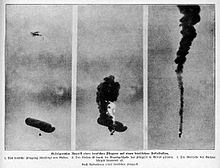 German war plane brings down "enemy's" tethered kite balloon (1918)
German war plane brings down "enemy's" tethered kite balloon (1918)
British blimps were used for scouting, mine clearance, and submarine attack duties. During the war, the British operated 226 airships, mostly non-rigid, most of which were of indigenous construction, though some non-rigid airships operated were purchased from France and even Germany (before the war).[38] Of that number several were sold to Russia, France, the US and Italy. Britain, in turn, purchased one M-type semi-rigid from Italy whose delivery was delayed until 1918. Nine rigid airships had been completed by the armistice, although several more were in an advanced state of completion by the war's end. The large number of trained crews, low attrition rate and constant experimentation in handling techniques meant that at the war's end Britain was the world leader in non-rigid airship technology.
Both France and Italy continued airships throughout the war. France preferred non-rigid types while Italy operated 49 semi-rigid airships in both the scouting and bombing roles.[39]
Airplanes had essentially replaced airships as bombers by the end of the war, and Germany's remaining zeppelins were scuttled by their crews, scrapped or handed over to the Allied powers as spoils of war. The British rigid airship program, meanwhile, had been largely a reaction to the potential threat of the German one and was largely, though not entirely, based on imitations of the German ships.
Inter-war period
A number of nations operated airships between the two world wars. Many operated blimps. Britain, the United States and Germany were the main operators of rigid airships with Italy and France using them to a lesser extent. Italy, the Soviet Union, United States and Japan mainly concentrated on semi-rigid airships. On May 12, 1926, The Italian Norge, a semi-rigid airship, was the first aircraft confirmed to fly over the North Pole.
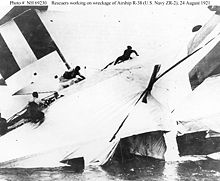 Rescuers scramble across the wreckage of British R-38/USN ZR-2, 24 August 1921
Rescuers scramble across the wreckage of British R-38/USN ZR-2, 24 August 1921
The British R33 and R34 were near-identical copies of the German L 33, which crashed virtually intact in Yorkshire on 24 September 1916.[40] Despite being almost three years out of date by the time they were launched in 1919, they were two of the most successful in British service. The creation of the Royal Air Force (RAF) in early 1918 created a hybrid British airship program. The RAF was not interested in airships and the Admiralty was, so a deal was made where the Admiralty would design any future military airships while the RAF would handle manpower, facilities and operations.[41] After the armistice, the airship program was rapidly wound down, and rigid airship operations were curtailed. On 2 July 1919, R34 began the first double crossing of the Atlantic by an aircraft. It landed at Mineola, Long Island on 6 July after 108 hours in the air. The return crossing began on 8 July because of concerns about mooring the ship in the open, and took 75 hours. Impressed, British leaders began to contemplate a fleet of airships to link Britain to its far-flung colonies, although post-war economic conditions led to the scrapping of most airships and dispersion of trained personnel. British airship developement resumed with the Imperial Airship Scheme of 1924, which produced the R-100 and R-101, both flown in in 1929. The major consequence of Britain's interest in establishing airship service to the empire was the effort to use the Allies' seizure of German airships and airship sheds to avoid competition from Germany.[42] The US Navy contracted to buy the British built R-38, but before that airship was turned over to the US, it was lost to structural failure due to both inadequate structural design and operation.[43]
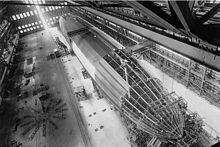 Construction of USS Shenandoah (ZR-1), 1923
Construction of USS Shenandoah (ZR-1), 1923
The first American-built rigid airship was USS Shenandoah, christened on 20 August in Lakehurst, New Jersey. It flew in 1923, while the Los Angeles was under construction. It was the first ship to be inflated with the noble gas helium, which was still so rare that the Shenandoah contained most of the world's reserves. When the Los Angeles was delivered, the two airships had to share the limited supply of Helium, and thus alternated operating and overhauls.[44]
For information about the legacy of the USS Shenandoah and its demise over rural Ohio, see Aaron J. Keirns' book America's Forgotten Airship Disaster: The Crash of the USS Shenandoah.
The United States Navy purchased what became the USS Los Angeles and paid with "war reparations" money, owed according to the Versailles Treaty, thus saving The Zeppelin works. The success of the Los Angeles encouraged the US Navy to invest in its own, larger airships. The Los Angeles flew successfully for 8 years.
Meanwhile Germany was building the Graf Zeppelin (LZ 127), the largest airship that could be built in the company's existing shed, and intended to stimulate interest in passenger airships. The Graf Zeppelin burned blau gas, similar to propane, stored in large gas bags below the hydrogen cells, as fuel. Since its density was similar to that of air, it avoided the weight change when fuel was used, and thus the need to valve hydrogen. The Graf was a great success and compiled an impressive safety record, flying over 1,600,000 km (990,000 mi) (including the first circumnavigation of the globe by air) without a single passenger injury.[45]
 USS Akron over Manhattan island circa 1932
USS Akron over Manhattan island circa 1932
The US Navy developed the idea of using airships as airborne aircraft carriers, although the British had experimented with a plane trapeze on their R33 many years before.[clarification needed] The USS Los Angeles was used to experiment with the project, followed by two other airships, the world's largest at the time, to test the principle—the USS Akron and Macon. Each carried four F9C Sparrowhawk fighters in its hangar, and could carry a fifth on the trapeze. The idea had mixed results. By the time the Navy started to develop a sound doctrine for using the ZRS-type airships, the last of the two built, USS Macon, was lost. The seaplane had become more mature, and was considered a better investment.[46]
Eventually the US Navy lost all three American-built rigid airships to accidents. USS Shenandoah on a poorly planned publicity flight flew into a severe thunderstorm over Noble County, Ohio on 3 September 1925. It broke into pieces, killing 14 of its crew. USS Akron was caught in a severe storm and flown into the surface of the sea off the shore of New Jersey on 3 April 1933. It carried no life boats and few life vests, so 73 of its crew of 76 died from drowning or hypothermia. USS Macon was lost after suffering a structural failure off the shore of Point Sur Lightstation State Historic Park on 12 February 1935. The failure caused a loss of gas, which was made much worse when the aircraft was driven over pressure height causing it to lose too much helium to maintain flight.[47] Only 2 of its crew of 83 died in the crash thanks to the inclusion of life jackets and inflatable rafts after the Akron disaster.
Britain's Burney Scheme and decline in airships
During the 1920s, Sir Dennistoun Burney suggested a plan for an air service throughout the British Empire using airships (the Burney Scheme).[41] Following the election of Ramsay MacDonald in 1924, the Burney scheme was transformed into a government-controlled program, the Imperial Airship Scheme, which contracted for two airships, one to be developed by the a private company, the Airship Guarantee Company, and the other under Air Ministry control by the Royal Airship Works. The two designs were radically different. The "capitalist" ship, the R100, was more conventional, while the "socialist" ship, the R101, had many innovative design features. Construction of both took longer than expected, and the airships did not fly until 1929. Neither airship was capable of the service intended, though the R100 did complete a proving flight to Canada and back in 1930.[48] However, on 5 October 1930 the R101, which had not been thoroughly tested after major modifications, crashed on its maiden voyage of life at Beauvais in France killing 48 of the 54 people aboard. Among the dead were the craft's chief designer and the Secretary of State for Air. Because of the bad publicity surrounding the crash, the Air Ministry grounded the competing R100 in 1930 and sold it for scrap in 1931, ending the era of British rigid airships.[49]
The Empire State Building was completed in 1931 with a dirigible mast, in anticipation of passenger airship service. Various entrepreneurs experimented with commuting and shipping freight via airship.[50]
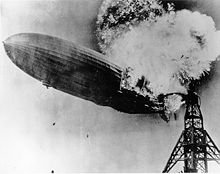 The Hindenburg — moments after catching fire, 6 May 1937
The Hindenburg — moments after catching fire, 6 May 1937 Zeppelin Tower in Recife - The only one in the world preserved in its original structure. 2007 photo
Zeppelin Tower in Recife - The only one in the world preserved in its original structure. 2007 photo
By the mid-1930s only Germany still pursued airship development. The Zeppelin company continued to operate the Graf Zeppelin on passenger service between Frankfurt and Recife in Brazil, taking 68 hours. Even with the small Graf Zeppelin, the operation was almost profitable.[51] In the mid-1930s work started to build an airship designed specifically to operate a passenger service across the Atlantic.[52] The Hindenburg (LZ 129) completed a very successful 1936 season carrying passengers between Lakehurst, New Jersey and Germany. 1937 started with the most spectacular and widely remembered airship accident. Approaching the mooring mast minutes before landing on 6 May 1937, the Hindenburg burst into flames and crashed. Of the 97 people aboard, 36 died: 13 passengers, 22 aircrew, and one American ground-crewman. The disaster happened before a large crowd, was filmed and a radio news reporter was recording the arrival. This was a disaster which theater goers could see and hear the next day. The Hindenburg disaster shattered public confidence in airships, and brought a definitive end to the "golden age". The day after Hindenburg crashed, the Graf Zeppelin landed at the end of its flight from Brazil, ending intercontinental passenger airship travel.
Hindenburg's sister ship, the Graf Zeppelin II (LZ 130), could not perform commercial passenger flights without helium, which the United States refused to sell. The Graf Zeppelin flew some test flights and conducted electronic espionage until 1939 when it was grounded due to the start of the war. The last two Zeppelins were scrapped in 1940.
Development of airships continued only in the United States, and to a smaller extent, the Soviet Union. The Soviet Union had several semi-rigid and non-rigid airships. The semi-rigid SSSR-V6 OSOAVIAKhIM was among the largest of these craft, and set the longest endurance flight at the time of over 130 hours. However, it crashed into a mountain in 1938, killing 13 of the 19 people on board. While this was a severe blow towards the Russian airship programme, they continued to operate non-rigid airships until 1950.
World War II
While Germany determined that airships were obsolete for military purposes in the coming war and concentrated on the development of airplanes, the United States pursued a program of military airship construction even though it had not developed a clear military doctrine for airship use. At the Japanese attack on Pearl Harbor on 7 December 1941 that brought the United States into World War II, it had 10 non-rigid airships:
- 4 K-class: K-2, K-3, K-4 and K-5 designed as patrol ships built from 1938.
- 3 L-class: L-1, L-2 and L-3 as small training ships, produced from 1938.
- 1 G-class built in 1936 for training.
- 2 TC-class that were older patrol ships designed for land forces, built in 1933. The US Navy acquired them from the United States Army in 1938.
Only K- and TC-class airships were suitable for combat and they were quickly pressed into service against Japanese and German submarines which were then sinking US shipping within visual range of the US coast. US Navy command, remembering the airship anti-submarine success from World War I, immediately requested new modern anti-submarine airships and on 2 January 1942 formed the ZP-12 patrol unit based in Lakehurst from the four K airships. The ZP-32 patrol unit was formed from two TC and two L airships a month later, based at NAS Moffett Field in Sunnyvale, California. An airship training base was created there as well. The status of submarine-hunting Goodyear airships in the early days of World War II has created significant confusion. Although various accounts refer to airships Resolute and Volunteer as operating as "privateers" under a Letter of Marque, Congress never authorized a commission, nor did the President sign one.[53]
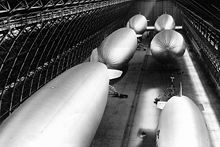 A view of six helium-filled blimps being stored in one of the two massive hangars located at NAS Santa Ana, during World War II.
A view of six helium-filled blimps being stored in one of the two massive hangars located at NAS Santa Ana, during World War II.
In the years 1942–44, approximately 1,400 airship pilots and 3,000 support crew members were trained in the military airship crew training program and the airship military personnel grew from 430 to 12,400. The US airships were produced by the Goodyear factory in Akron, Ohio. From 1942 till 1945, 154 airships were built for the US Navy (133 K-class, 10 L-class, seven G-class, four M-class) and five L-class for civilian customers (serial numbers L-4 to L-8).
The primary airship tasks were patrol and convoy escort near the US coastline. They also served as an organisation center for the convoys to direct ship movements, and were used in naval search and rescue operations. Rarer duties of the airships included aerophoto reconnaissance, naval mine-laying and mine-sweeping, parachute unit transport and deployment, cargo and personnel transportation. They were deemed quite successful in their duties with the highest combat readiness factor in the entire US air force (87%).
In 1944-45, the United States Navy moved an entire squadron of eight Goodyear K class blimps (K-123, K-130, K-109, K-134, K-101, K-112, K-89, & K-114) with flight and maintenance crews from Weeksville Naval Air Station in North Carolina to Port Lyautey, French Morocco. Their mission was to locate and destroy German U-boats in the relatively shallow waters around the Strait of Gibraltar where magnetic anomaly detection (MAD) was viable. PBY aircraft had been searching these waters but MAD required low altitude flying that was dangerous at night for these aircraft. The blimps were considered a perfect solution to establish a 24/7 MAD barrier (fence) at the Straits of Gibraltar with the PBYs flying the day shift and the blimps flying the night shift. The first two blimps (K-123 & K-130) left South Weymouth NAS on 28 May 1944 and flew to Argentia, Newfoundland, the Azores, and finally to Port Lyautey where they completed the first transatlantic crossing by non-rigid airships on 1 June 1944. The blimps of USN Blimp Squadron ZP-14 (Blimpron 14, aka The Africa Squadron) also conducted mine-spotting and minesweeping operations in key Mediterranean ports and various escorts including the convoy carrying United States President Franklin D. Roosevelt and British Prime Minister Winston Churchill to the Yalta Conference in 1945.[54]
During the war some 532 ships without airship escort were sunk near the US coast by enemy submarines. Only one ship, the tanker Persephone, of the 89,000 or so in convoys escorted by blimps was sunk by the enemy.[55] Airships engaged submarines with depth charges and, less frequently, with other on-board weapons. They were excellent at driving submarines down, where their limited speed and range prevented them from attacking convoys. The weapons available to airships were so limited that until the advent of the homing torpedo they had little chance of sinking a submarine.[56]
Only one airship was ever destroyed by U-boat: on the night of 18/19 July 1943, a K-class airship (K-74) from ZP-21 division was patrolling the coastline near Florida. Using radar, the airship located a surfaced German submarine. The K-74 made her attack run but the U-boat opened fire first. K-74's depth charges did not release as she crossed the U-boat and the K-74 received serious damage, losing gas pressure and an engine but landing in the water without loss of life. The crew was rescued by patrol boats in the morning, but one crewman, Aviation Machinist's Mate Second Class Isadore Stessel, died from a shark attack. The U-Boat, submarine U-134, was slightly damaged and the next day or so was attacked by aircraft, sustaining damage that forced it to return to base. It was finally sunk on 24 August 1943 by a British Vickers Wellington near Vigo, Spain[57][58]
Fleet Airship Wing One operated from Lakehurst, NJ, Glynco, GA, Weeksville, NC, South Weymouth NAS Massachusetts, Brunswick NAS and Bar Harbor ME, Yarmouth, Nova Scotia, and Argentia, Newfoundland.
Some US airships saw action in the European war theatre. The ZP-14 unit operating in the Mediterranean area from June 1944 completely denied the use of the Gibraltar Straits to Axis submarines. Airships from the ZP-12 unit took part in the sinking of the last U-Boat before German capitulation, sinking U-881 on 6 May 1945 together with destroyers Atherton and Mobery.
Other airships patrolled the Caribbean, Fleet Airship Wing Two, Headquartered at NAS Richmond, Florida, covered the Gulf of Mexico from Richmond and Key West, FL, Houma, Louisiana, as well as Hitchcock and Brownsville, Texas. FAW 2 also patrolled the northern Caribbean from San Julian,[clarification needed] the Isle of Pines (now called Isla de la Juventud) and Guantanamo Bay, Cuba as well as Vernam Field, Jamaica.
Navy blimps of Fleet Airship Wing Five, (ZP-51) operated from bases in Trinidad, British Guiana and Parmaribo, Dutch Guiana. Fleet Airship Wing Four operated along the coast of Brazil. Two squadrons, VP-41 and VP-42 flew from bases at Amapá, Igarape Assu, Sao Luiz, Fortaleza, Fernando de Noronha, Recife, Maceió, Ipitanga (near Salvador, Bahia), Caravellas, Vitoria and the hangar built for the Graf Zeppelin at Santa Cruz, Rio de Janeiro.
Fleet Airship Wing Three operated squadrons, ZP-32 from Moffett Field, ZP-31 at NAS Santa Ana, and ZP-33 at NAS Tillamook, Oregon. Auxiliary fields were at Del Mar, Lompoc, Watsonville and Eureka, CA, North Bend and Astoria, Oregon, as well as Shelton and Quillayute in Washington.
From 2 January 1942 till the end of war airship operations in the Atlantic, the airships of the Atlantic fleet made 37,554 flights and flew 378,237 hours. Of the over 70,000 ships in convoys protected by blimps, only one was sunk by a submarine while under blimp escort.[56]
The Soviet Union used a single airship during the war. The W-12, built in 1939, entered service in 1942 for paratrooper training and equipment transport. It made 1432 runs with 300 metric tons of cargo until 1945. On 1 February 1945, the Soviets constructed a second airship, a Pobeda-class (Victory-class) unit (used for mine-sweeping and wreckage clearing in the Black Sea) which crashed on 21 January 1947. Another W-class - W-12bis Patriot - was commissioned in 1947 and was mostly used for crew training, parades and propaganda.
Modern use
Although airships are no longer used for passenger transport, they are still used for other purposes such as advertising, sightseeing, surveillance and research.
In the 1980s, Per Lindstrand and his team introduced the GA-42 airship, the first airship to use fly-by-wire flight control which considerably reduced the pilot's workload.
The world's largest thermal airship (300,000 cubic feet/8,495 m³) was constructed by the Per Lindstrand company for French botanists in 1993. The AS-300 carried an underslung raft, which was positioned by the airship on top of tree canopies in the rain forest, allowing the botanists to carry out their treetop research without significant damage to the rainforest. When research was finished at a given location, the airship returned to pick up and relocate the raft.[59]
In the spring of 2004, Lindstrand Technologies supplied the world's first fully functional unmanned airship to the Ministry of Defense in Spain. This airship carried a 42 kilograms (93 lb) classified payload and its surveillance mission was also classified. Four years later, this airship, which is designated GA-22, still flies on an almost daily basis.
In June 1987, the US Navy awarded a US$168.9 million contract to Westinghouse Electric and Airship Industries of the UK to demonstrate whether a blimp could be used as an airborne platform to detect the threat of sea-skimming missiles, such as the Exocet.[60] At 2.5 million cubic feet, the Westinghouse/Airship Industries Sentinel 5000 (Redesignated YEZ-2A by the U. S. Navy) prototype design was to have been the largest blimp ever constructed.[61] However, additional funding for the Naval Airship Program was killed in 1995 and development was discontinued.
The CA-80 airship, which was launched in 2000 by Shanghai Vantage Airship Manufacture Co., Ltd., had a successful trial flight in September 2001. This model of airship was designed for the purpose of advertisement and propagation, air-photo, scientific test, tour and surveillance duties. It was certified as a grade-A Hi-Tech introduction program (№ 20000186) in Shanghai, China. The CAAC authority granted a type design approval and certificate of airworthiness for the model CA-80 airship, which has been published in the Jane's All the World's Aircraft for five times (2003–08).[62]
In recent years, the Zeppelin company has reentered the airship business. Their new model, designated the Zeppelin NT, made its maiden flight on 18 September 1997. As of 2009, there were four NT aircraft flying, a fifth completed in March 2009 and an expanded NT-14 (14,000 cubic meters of helium, capable of carrying 19 passengers) under construction. One was sold to a Japanese company, and was planned to be flown to Japan in the summer of 2004. Due to delays getting permission from the Russian government, the company decided to transport the airship to Japan by ship. One of the four NT craft is in South Africa carrying diamond detection equipment from De Beers, an application at which the very stable low vibration NT platform excels. The project included design adaptations for high heat operation and desert climate, as well as a separate mooring mast and a very heavy mooring truck. NT-4 belongs to Airship Ventures of Moffett Field, Mountain View in the San Francisco Bay Area, and provides sight-seeing tours
Blimps are used for advertising and as TV camera platforms at major sporting events. The most iconic of these are the Goodyear blimps. Goodyear operates three blimps in the United States, and The Lightship Group operates up to 19 advertising blimps around the world. Airship Management Services owns and operates three Skyship 600 blimps. Two operate as advertising and security ships in North America and the Caribbean.
Skycruise Switzerland AG owns and operates two Skyship 600 blimps. One operates regularly over Switzerland used on sightseeing tours.
The Switzerland-based Skyship 600 has also played other roles over the years. For example, it was flown over Athens during the 2004 Summer Olympics as a security measure. In November 2006, it carried advertising calling it The Spirit of Dubai as it began a publicity tour from London to Dubai, UAE on behalf of The Palm Islands, the world's largest man-made islands created as a residential complex.
Los Angeles-based Worldwide Aeros Corp. produces FAA Type Certified Aeros 40D Sky Dragon airships.[63]
In May 2006, the US Navy began to fly airships again after a hiatus of nearly 44 years. The program uses a single American Blimp Company A-170 non-rigid airship, with designation MZ-3A. Operations focus on crew training and research, and the platform integrator is Northrop Grumman. The program is directed by the Naval Air Systems Command and is being carried out at NAES Lakehurst, the original center of US Navy lighter-than-air operations in previous decades.
In November 2006, the US Army bought an A380+ airship from American Blimp Corporation through a Systems level contract with Northrop Grumman and Booz Allen Hamilton. The airship started flight tests in late 2007, with a primary goal of carrying 2,500 lb (1,100 kg) of payload to an altitude of 15,000 ft (4,600 m) under remote control and autonomous waypoint navigation. The program will also demonstrate carrying 1,000 lb (450 kg) of payload to 20,000 ft (6,100 m) The platform could be used for Multi-Intelligence collections. In 2008, the CA-150 airship was launched by Vantage Airship. This is an improved modification of model CA-120 and completed manufacturing in 2008. With larger volume and increased passenger capacity, it is the largest manned non-rigid airship in China at present.[64]
In 2010, the US Army awarded a $517 million (£350.6 million) contract to Northrop Grumman and partner Hybrid Air Vehicles,[65] to develop a Long Endurance Multi-Intelligence Vehicle (LEMV) system, in the form of three HAV 304's.[66][67][68][69][69][70]
An airship was prominently featured in the James Bond film A View to a Kill, released in 1985. The Skyship 500 had the livery of Zorin Industries.[71]
Recent developments
In the 1930s, Zeppelins successfully competed with other means of transatlantic transport. Their advantages included the ability to carry significantly more passengers than other contemporary aircraft in greater comfort with less engine noise, vibration and turbulence, while providing amenities similar to those on ocean liners, such as private cabins, observation decks, dining rooms, and even a smoking lounge on the Hindenburg. Less importantly, the technology was potentially more energy-efficient than heavier-than-air designs. Zeppelins were also faster than ocean liners. On the other hand, operating the giants was quite involved, especially in terms of personnel. Often the crew would outnumber passengers on board, and on the ground large teams were necessary to assist starting and landing. Also, to accommodate Zeppelins like Hindenburg (which at 245 metres length was more than two times the length of a typical football pitch), very large hangars were required at airports.
Today, with large, fast, and more cost-efficient fixed-wing aircraft, it is unknown whether huge airships can operate profitably in regular passenger transport though, as energy costs rise, attention is once again returning to these lighter than air vessels as a viable alternative. At the very least, the idea of comparatively slow, "majestic" cruising at relatively low altitudes and in comfortable atmosphere certainly has retained some appeal. There have been some niches for airships in and after World War II, such as long-duration observations, antisubmarine patrol, platforms for TV camera crews, and advertising; these, however, generally require only small and flexible craft, and have thus generally been better fitted for cheaper blimps.
Heavy lifting
It has periodically been suggested that airships could be employed for cargo transport, especially delivering extremely heavy loads to areas with poor infrastructure over great distances. This has also been called roadless trucking.[72] Also, airships could be used for heavy lifting over short distances (e.g. on construction sites); this is described as heavy-lift, short-haul.[73] In both cases, the airships are heavy haulers. One recent enterprise of this sort was the Cargolifter project, in which a hybrid (thus not entirely Zeppelin-type) airship even larger than Hindenburg was projected. Around 2000, CargoLifter AG built the world's largest cantilever shop hall measuring 360 m (1,180 ft) long, 210 m (690 ft) wide and 107 m (351 ft) high about 60 km (37 mi) south of Berlin. In May 2002, the project was stopped for financial reasons; the company had to file bankruptcy. Although no rigid airships are currently used for heavy lifting, hybrid airships are being developed for such purposes. John McPhee's The Deltoid Pumpkin Seed is the story of one company attempting this.
Passenger transport
 A Zeppelin NT airship
A Zeppelin NT airship
In the 1990s, the successor of the original Zeppelin company in Friedrichshafen, the Zeppelin Luftschifftechnik GmbH, reengaged in airship construction. The first experimental craft (later christened Friedrichshafen) of the type Zeppelin NT flew in September 1997. Though larger than common blimps, the Neue Technologie (new technology) Zeppelins are much smaller than their giant ancestors and not actually Zeppelin-types in the classical sense; they are sophisticated semi-rigids. Apart from the greater payload, their main advantages compared to blimps are higher speed and excellent maneuverability. Meanwhile, several Zeppelin NT have been produced and operated profitably in joyrides, research flights and similar applications.
In June 2004, a Zeppelin NT was sold for the first time to a Japanese company, Nippon Airship Corporation, for tourism and advertising mainly around Tokyo. It was also given a role at the 2005 Expo in Aichi. The aircraft began a flight from Friedrichshafen to Japan, stopping at Geneva, Paris, Rotterdam, Munich, Berlin, Stockholm and other European cities to carry passengers on short legs of the flight. However, Russian authorities denied overflight permission so the airship had to be dismantled and shipped to Japan rather than following the historic Graf Zeppelin flight from Germany to Japan.
In 2008, Airship Ventures Inc. began operations from Moffett Federal Airfield near Mountain View, California and currently offers tours of the San Francisco Bay Area for up to 12 passengers.
Use in exploration
In November 2005, De Beers, the diamond mining company, launched an airship exploration program over the remote Kalahari desert. A Zeppelin, loaded with high-tech equipment, is used to find potential diamond mines by scanning the local geography for low-density rock formations - so-called kimberlite pipes. On 21 September 2007, the airship was severely damaged by a whirlwind while in Botswana. One crew member, who was on watch aboard the moored craft, was slightly injured but released after overnight observation in hospital.
Thermal airships and remotes
 Thermal airship (manufacturer GEFA-FLUG/Germany)
Thermal airship (manufacturer GEFA-FLUG/Germany)
Several companies, such as Cameron Balloons in Bristol, United Kingdom, build hot-air airships. These combine the structures of both hot-air balloons and small airships. The envelope is the normal cigar shape, complete with tail fins, but is inflated with hot air (as in a balloon) to provide the lifting force, instead of helium. A small gondola, carrying the pilot and passengers, a small engine, and the burners to provide the hot air are suspended below the envelope, below an opening through which the burners protrude.
Hot-air airships typically cost less to buy and maintain than modern helium-based blimps, and can be quickly deflated after flights. This makes them easy to carry in trailers or trucks and inexpensive to store. They are usually very slow moving, with a typical top speed of 25–30 km/h (15–20 mph, 6.7–8.9 m/s). They are mainly used for advertising, but at least one has been used in rainforests for wildlife observation, as they can be easily transported to remote areas.
Remote-controlled (RC) airships, a type of unmanned aerial system (UAS), are sometimes used for commercial purposes such as advertising and aerial video and photography as well as recreational purposes. They are particularly common as an advertising mechanism at indoor stadiums. While RC airships are sometimes flown outdoors, doing so for commercial purposes is illegal in the US. In particular, Docket FAA-2006-25714 states that: "The FAA recognizes that people and companies other than modelers might be flying UAS with the mistaken understanding that they are legally operating under the authority of AC 91-57. AC 91-57 only applies to modelers, and thus specifically excludes its use by persons or companies for business purposes."[74] The same docket item identifies 14CFR121 as the appropriate certification basis for experimental unmanned aircraft, which would included unmanned airships operating for commercial purposes, so commercial use of a unmanned airship is not prohibited - instead it must be certified under part 121 not 91.
A total of 4,700 total airships and blimps exist across the world.
Present-day research
Prototypes and experimental models
Hybrid designs such as the Heli-Stat airship/helicopter, the Aereon aerostatic/aerodynamic craft, and the CycloCrane (a hybrid aerostatic/rotorcraft), have struggled to take flight. The Cyclocrane was also interesting in that the airship's envelope rotated along its longitudinal axis.
In 2005, a short-lived project of the US Defense Advanced Research Projects Agency (DARPA) was WALRUS HULA which explored the potential for using airships as long-distance, heavy lift craft.[75][76] The primary goal of the research program was to determine the feasibility of building an airship capable of carrying 500 short tons (450 t) of payload a distance of 12,000 mi (19,000 km) and land on an unimproved location without the use of external ballast or ground equipment (such as masts). In 2005, two contractors, Lockheed Martin and US Aeros Airships were each awarded approximately $3 million to do feasibility studies of designs for WALRUS. In late March 2006, DARPA announced the termination of work on WALRUS after completion of the current Phase I contracts.[citation needed]
The US government is funding two major projects in the high altitude arena. The Composite Hull High Altitude Powered Platform (CHHAPP) is sponsored by US Army Space and Missile Defense Command. This aircraft is also sometimes called HiSentinel High-Altitude Airship. This prototype ship made a five-hour test flight in September 2005. The second project, the high-altitude airship (HAA), is sponsored by DARPA. In 2005, DARPA awarded a contract for nearly $150 million to Lockheed Martin for prototype development. First flight of the HAA is planned for 2008.
On 31 January 2006 Lockheed Martin made the first flight of their secretly built hybrid airship designated the P-791. The design is very similar to the SkyCat, unsuccessfully promoted for many years by the now financially troubled British company Advanced Technology Group. Although Lockheed Martin is developing a design for the DARPA WALRUS HULA project, it claimed that the P-791 is unrelated to WALRUS. Nonetheless, the design represents an approach that may well be applicable to WALRUS. Some believe that Lockheed Martin had used the secret P-791 program as a way to get a head start on the other WALRUS competitor, US Aeros Airships.[citation needed]
Hybrid airship
A hybrid airship is a general term for an aircraft that combines characteristics of heavier-than-air (airplane or helicopter) and lighter-than-air technology. Examples include helicopter/airship hybrids intended for heavy lift applications and dynamic lift airships intended for long-range cruising. It should be noted that most airships, when fully loaded with cargo and fuel, are usually ballasted to be heavier than air, and thus must use their propulsion system and shape to create aerodynamic lift, necessary to stay aloft. All airships can be operated to be slightly heavier than air at periods during flight (descent). However, the term "hybrid airship" refers to craft that obtain a significant portion of their lift from aerodynamic lift or other kinetic means.
For example, the Aeroscraft is a buoyancy assisted air vehicle that generates lift through a combination of aerodynamics, thrust vectoring and gas buoyancy generation and management, and for much of the time will fly heavier than air. Aeroscraft is Worldwide Aeros Corporation's continuation of DARPA's now cancelled Walrus HULA(Hybrid Ultra Large Aircraft) project.[77]
Practical comparison with heavier-than-air aircraft
The advantage of airships over airplanes is that static lift sufficient for flight is generated by the lifting gas and requires no engine power. This was an immense advantage before the middle of World War I and remained an advantage for long distance, or long duration operations until World War II. Modern concepts for high altitude airships include photovoltaic cells to reduce the need to land to refuel, thus they can remain in the air until consumables expire.
The disadvantages are that an airship has a very large reference area and comparatively large drag coefficient, thus a larger drag force compared to that of airplanes and even helicopters. Given the large frontal area and wetted surface of an airship, a practical limit is reached around 80–100 miles per hour (130–160 km/h). Thus airships are used where speed is not critical.
The gross lift capability of an airship is equal to the buoyant force minus the weight of the airship. This assumes standard air temperature and pressure conditions. Corrections are usually made for water vapor and impurity of lifting gas, as well as percentage of inflation of the gas cells at liftoff.[78] Based on specific lift (pounds of lift per thousand cubic feet of lifting gas), the greatest static lift is provided by hydrogen (71 lbs. lift/1000 cubic feet of gas) with helium (66 lbs. lift/1000 cubic feet of gas) a close second.[79] At 39 lbs./1000 cubic feet, steam is a distant third. Other gases, such as methane, carbon monoxide, ammonia and natural gas[citation needed] have even less lifting capacity and are flammable, toxic, corrosive, or all three. Operational considerations such as whether the lift gas can be economically vented and produced in flight for control of buoyancy (as with hydrogen) or even produced as a byproduct of propulsion (as with steam) affect the practical choice of lift gas in airship designs.
Considering the Hindenburg disaster, one may question why such a flammable gas as hydrogen was used in the first place, when it is only marginally better than helium as a lifting gas. The answer is that hydrogen can be produced easily and economically through the electrolysis of water or by chemical reactions, whereas helium is scarce and expensive, occurring only in trace amounts in a few natural gas deposits.
In addition to static lift, an airship can obtain a certain amount of dynamic lift from its engines. Dynamic lift in past airships has been about 10% of the static lift. Dynamic lift allows an airship to "take off heavy" from a runway similar to fixed-wing and rotary-wing aircraft. However, this requires additional weight in engines, fuel and landing gear, negating some of the static lift capacity.
The altitude at which an airship can fly largely depends on how much lifting gas it can lose due to expansion before stasis is reached. The ultimate altitude record for a rigid airship was set in 1917 by the L-55 under the command of Hans-Kurt Flemming when he forced the airship to 24,000 ft (7,300 m) attempting to cross France after the "Silent Raid" on London. The L-55 lost lift as the descent to lower altitudes over Germany compressed the gas left in the cells, and thus the weight of air displaced. L-55 crashed due to loss of lift.[80] While such waste of gas was necessary for the survival of airships in the later years of WW I, it was impractical for commercial operations, or operations of helium-filled military airships. The highest flight made by a hydrogen filled passenger airship was 5,500 ft (1,700 m) on the Graf Zeppelin's around the world flight.[81] The practical limit for rigid airships was about 3,000 feet (900 m), and for pressure airships around 8,000 ft (2,400 m).[citation needed]
Modern airships use dynamic helium volume. At sea level altitude, helium only takes up a small part of the hull, while the rest is filled with air. As the airship ascends, the helium inflates with reduced outer pressure, and air is pushed out and released from the downward valve. This allows an airship to reach any altitude with balanced inner and outer pressure if the buoyancy is enough. Some civil aerostats could reach 100,000 ft (30,000 m) without explosion due to overloaded inner pressure.[citation needed]
The greatest disadvantage of the airship is size, which is essential to increasing performance. As size increases, the problems of ground handling increase geometrically.[82] As the German Navy transitioned from the "p" class Zeppelins of 1915 with a volume of over 1,100,000 cu ft (31,000 m3) to the larger "q" class of 1916, the "r" class of 1917, and finally the "w" class of 1918, at almost 2,200,000 cu ft (62,000 m3) ground handling problems reduced the number of days the Zeppelins were able to make patrol flights. This availability declined from 34% in 1915, to 24.3% in 1916 and finally 17.5% in 1918.[83]
So long as the power-to-weight ratios of aircraft engines remained low and specific fuel consumption high, the airship had an edge for long range or duration operations. As those figures changed, the balance shifted rapidly in the airplane's favor. By mid-1917 the airship could no longer survive in a combat situation where the threat was airplanes. By the late 1930s, the airship barely had an advantage over the airplane on intercontinental over-water flights, and that advantage had vanished by the end of WW II.
This is in face-to-face tactical situation, current High Altitude Airship project is planned to survey hundreds of kilometers as their operation radius, often much farther than normal engage range of a military airplane.[clarification needed] This provides better early warning, even farther than the Aegis system.[clarification needed] The current Aegis system is often based on a sea vessel like Ticonderoga Class and Burke Class, which have restricted radio horizon and line of sight.[clarification needed] For example, a radar mounted on a vessel platform 30 m (100 ft) high has radio horizon at 20 km (12 mi) range, while a radar at 18,000 m (59,000 ft) altitude has radio horizon at 480 km (300 mi) range. This is significantly important for detecting low-flying cruise missiles or fighter-bombers.
The blimp remained a viable military system only until the conventional submarine was replaced by the nuclear submarine. Today, airships are used primarily for command, control and as a communication platform; to establish and maintain reliable and secure connectivity among all forces, provide transparent data across the echelons; precisely locate friendly and enemy forces; detect targets on an extended battlefield at a minimal exposure to enemy forces; real time targeting; navigation assistance; battle management; monitor radio conversations, etc.
Safety
The most commonly used lift gas, helium, is inert so acts as a fire extinguisher.[84] Modern airships have a natural buoyancy and special design that offers a virtually zero catastrophic failure mode.[85] While on long-haul flights weather patterns would be flown to avoid bad weather, the hull's mass largely dampens the effect of turbulence, just as a large tanker rides through rough seas.[citation needed] An airship is usually a poor lightning target,[citation needed] as it is constructed mainly from composite materials. If it is struck, built-in protection devices minimise the risk to the vehicle and its cargo.[citation needed]
A series of structural vulnerability tests were done by the UK Defence Evaluation and Research Agency DERA on a Skyship 600, an earlier airship built by the Munk team to a similar pressure-stabilised design. Several hundred high-velocity bullets were fired through the hull, and even two hours later the vehicle would have been able to return to base. The airship is virtually impervious to automatic rifle and mortar fire: ordnance passes through the envelope without causing critical helium loss. In all instances of light armament fire evaluated under both test and live conditions, the vehicle was able to complete its mission and return to base. The internal hull pressure is maintained at only 1–2% above surrounding air pressure, the vehicle is highly tolerant to physical damage or to attack by small-arms fire or missiles.[86]
See also
- Airship hangar
- Dirisoft
- Evolutionary Air and Space Global Laser Engagement
- High-altitude platform
- Hyperion airship, fictional airship type.
- List of airship accidents
- List of Zeppelins
- Metaplane
- Mystery airship
- Stratellite
- SVAM CA-80
Footnotes
- ^ Some post-WW2 airships still used hydrogen. The first British airship to use helium was Chitty Bang Bang of 1967.
- ^ Mowthorpe, C. E. S. Battlebags, British Airships of the First World War, Phonix Mill, United Kingdom. Alan Sutton Publishing, 1995, p. xx. ISBN 0-7509-0989-7
- ^ "JP Aerospace Airship Flies To The Edge Of Space". October 27, 2011. http://www.aero-news.net/index.cfm?do=main.textpost&id=0fcb3845-ad1f-4b08-b6f1-8a7e5d0c66e6.
- ^ Dooley, A.185-A.186 citing Robinson, pp.2-3 collapsed on inflation
- ^ Dooley, A.193 (at Tempelhof, Berlin in 1897, landed but then collapsed)
- ^ NAS Grosse Ile, NASGIVM. 2006.
- ^ National Air and Space Museum, Smithsonian Institution. 2008. Slate Aircraft Corporation City of Glendale Negatives, Accession number 2006-0039
- ^ City of Glendale. Photo Album. Retrieved 3 September 2008.
- ^ Both non-rigid ships nevertheless had strong metal monocoque envelopes which, while they maintained their shape uninflated, required an overpressure during flight.
- ^ "Francesco Lana-Terzi, S.J. (1631-1687); The Father of Aeronautics". http://www.faculty.fairfield.edu/jmac/sj/scientists/lana.htm. Retrieved 24 July 2010.
- ^ "Would a balloon filled with vacuum instead of helium float?". http://science.howstuffworks.com/question194.htm. Retrieved 24 July 2010.
- ^ Winter & Degner (1933), pp. 26–27.
- ^ Winter & Degner (1933), p. 36.
- ^ Toland, John (1972). The great dirigibles: their triumphs and disasters. Courier Dover Publications. p. 15. ISBN 0486213978. http://books.google.com/?id=xY7Uy2mO9cQC. Retrieved 2010-01-12. "ISBN 9780486213972" (unabridged republication of the Holt edition 1957, titled Ships in the Sky: The Story of the Great Dirigibles)
- ^ Brooks 1992 p. 19.
- ^ Winter & Degner (1933), p. 44.
- ^ a b c Bento S. Mattos, Short History of Brazilian Aeronautics (PDF), 44th AIAA Aerospace Sciences Meeting and Exhibit, Reno, Nevada, 9–12 January 2006.
- ^ Winter & Degner (1933), pp. 49–50.
- ^ Scientific American - 27 July 1889
- ^ Brooks 1992 p. 20.
- ^ Mercedes-Benz Museum (Trip II): The beginning, gminsidenews.com, 2007.
- ^ Member's Circular Letter February 2008, zeppelin-tourismus.de.
- ^ International, Inc Icon Group (2008-11-26). Croatians: Webster's Quotations, Facts and Phrases. ISBN 9780546701173. http://books.google.com/?id=vkpLh-XBcG0C&pg=PA34&dq=%22David+Schwarz%22++aviation+croatian#v=onepage&q=%22David%20Schwarz%22&f=false.
- ^ Brooks 1992 pp. 27–31.
- ^ Niccoli, R. The Book of Flight: From the flying machines of Leonardo da Vinci to the conquest of space, New York, Friedman/Fairfax, 2002, p. 24. ISBN 978-1-58663-716-3
- ^ Toland (1957), pp. 25–37.
- ^ "AN AIRSHIP TRAVELS NEARLY THIRTY MILES". New York Times. 1902-09-20. http://query.nytimes.com/mem/archive-free/pdf?res=F00F10FF355414728DDDA90A94D1405B828CF1D3. Retrieved 30 April 2011. "well-known English aeronaut"
- ^ "WAYS OF AIRSHIPS". The Star (Christchurch): p. 2. 1903-12-31. http://paperspast.natlib.govt.nz/cgi-bin/paperspast?a=d&d=TS19031231.2.12&l=mi&e=-------10--1----2--. Retrieved 30 April 2011. "well-known aeronaut"
- ^ Toland (1957), pp. 49–51.
- ^ Lueger 1920, pp.404-412, Luftschiff
- ^ Ligugnana, Sandro
- ^ Ventry & Koesnik (1982), p. 85.
- ^ Robinson (1973), pp. 126–127.
- ^ Robinson (1994), p. 360.
- ^ Robinson (1994), pp. 340–341.
- ^ Higham (1961), p. 25.
- ^ Higham (1961), p. 40.
- ^ Higham (1961), p. 111.
- ^ Mowthorpe, Ces, Battlebags, Stroud, Gloucs, Allan Sutton Publishing, 1995, p. xxiii.
- ^ Ventry & Koesnik (1982), p. 97.
- ^ Higham (1961), p. 138.
- ^ a b Higham (1961), p. 176.
- ^ Higham (1961), p. 191.
- ^ Higham 1961, pp. 222–223.
- ^ Althoff, William F., USS Los Angeles, Washington DC, Brassey's, 2004, p. 48, ISBN 1-57488-620-7
- ^ Botting, Douglas, Dr. Eckener's Dream Machine, New York, Henry Hold, 2001, ISBN 0-8050-6458-3
- ^ Smith (1965), pp. 171–174.
- ^ Smith (1965), pp. 157–161.
- ^ Countryman, Barry, R100 in Canada, Erin, Ontario, Boston Mills, 1982, ISBN 0-919822-36-3
- ^ Leasor, James, The Millionth Chance, New York, Reynal, 1957, LCC 58-7405
- ^ "Intercity Dirigible Service". 2010-02-26. http://www.uh.edu/engines/epi2571.htm. Retrieved 2010-10-01.
- ^ Botting, Douglas, Dr. Eckener's Dream Machine. New York, Henry Hold, 2001, p. 235, ISBN 0-8050-6458-3
- ^ Dick, Harold G., with Robinson, Douglas H., Graf Zeppelin & Hindenburg, Washington DC, Smithsonian Institution Press, 1985, p. 83, ISBN 0-87474-346-8
- ^ Theodore Richard, Reconsidering the Letter of Marque: Utilizing Private Security Providers Against Piracy (April 1, 2010). Public Contract Law Journal, Vol. 39, No. 3, pp. 411-464 at 429 n.121, Spring 2010. Available at SSRN: http://ssrn.com/abstract=1591039
- ^ Kaiser, Don,Blimp Squadron 14, WarWingsArt.com. Retrieved 16 September 2009.
- ^ Vaeth, J. Gordon, Blimps & U-Boats, Anapolis, MD, US Naval Institute Press, 1992, pp. 20–21, ISBN 1-55750-876-3
- ^ a b Vaeth, J. Gordon, Blimps & U-Boats, Anapolis, MD, US Naval Institute Press, 1992, ISBN 1-55750-876-3
- ^ U.S. Navy LTA history.
- ^ U-134 history, Uboat.net.
- ^ Thermal Airships, Lindstrand Technologies.
- ^ "The New York Times". Reuters. 6 June 1987. http://query.nytimes.com/gst/fullpage.html?res=9B0DEFDC1E30F935A35755C0A961948260. Retrieved 6 November 2007.
- ^ All the World's Aircraft 1992–93. Jane. 1992.
- ^ CA-80 Blimp. Vantage Ship. 2000. http://www.vantageship.com/en_ca80data.htm.
- ^ "Worldwide Aeros Corp". http://www.aerosml.com/.
- ^ CA-150 Blimp. Vantage Ship. 2008. http://www.vantageship.com/en_zairenfeiting.htm.
- ^ "Hybrid Air Vehicles". http://www.hybridairvehicles.com/.
- ^ "The Difference Engine: Not all hot air"", The Economist, July 29th 2010
- ^ "Photo Release — Northrop Grumman Awarded $517 Million Agreement for US Army Airship With Unblinking Eye", Northrup Grumman, June 14, 2010, access date July 29, 2010
- ^ "250-Foot Long Hybrid Airship Will Spy Over Afghanistan Battlefields in 2011". Gizmodo. 2009-09-23. http://gizmodo.com/5366082/250+foot-long-hybrid-airship-will-spy-over-afghanistan-battlefields-in-2011. Retrieved 2010-07-29.
- ^ a b 15-Jul-2010 11:15 EDT (2010-07-15). "Rise of the "Blimps": The US Army’s LEMV". Defenseindustrydaily.com. http://www.defenseindustrydaily.com/Rise-of-the-Blimps-The-US-Armys-LEMV-06438/. Retrieved 2010-07-29.
- ^ Graham Warwick. "Hybrid Airship for Afghan ISR Takes Shape". Aviation Week. http://www.aviationweek.com/aw/blogs/defense/index.jsp?plckController=Blog&plckScript=blogScript&plckElementId=blogDest&plckBlogPage=BlogViewPost&plckPostId=Blog%3A27ec4a53-dcc8-42d0-bd3a-01329aef79a7Post%3Af2996a4f-f738-4cb2-8157-afba2eb5ca28. Retrieved 2010-07-29.
- ^ "IMDb". http://www.imdb.com/title/tt0090264/.
- ^ "Roadless trucking", Dynalifter.
- ^ "Boeing and SkyHook International to Build JHL-40 Heavy-Lift Rotorcraft", press release, 8 July 2008.
- ^ FAA Docket FAA-2006-25714, Federal Aviation Authority.
- ^ "Contractors for Walrus Program announced", press release, Defense Advanced Research Projects Agency, 26 August 2005.
- ^ "US CBO Gives OK to HULA Airships for Airlift", Defense Industry Daily, 21 October 2005.
- ^ "Aeroscraft.com". http://www.aeroscraft.com/. Retrieved 24 July 2010.
- ^ Ausrotas, R. A., "Basic Relationships for LTA Technical Analysis," MIT Flight Transportation Library, 1975
- ^ Layton, D. M., Basic Aerostatics -- A Tutorial, 1985
- ^ Robinson (1994), p. 294.
- ^ "Honors to Dr. Hugo Eckener: The First Airship Flight Around the World", National Geographic, Vol. LVII, No. 6, June 1930, p. 679.
- ^ Brooks 1992 pp. 7-8
- ^ Robinson (1994), p. 373.
- ^ Stwertka, Albert, Guide to the Elements: Revised Edition. New York; Oxford University Press, 1998, p. 24. ISBN 0-19-512708-0
- ^ http://www.youtube.com/watch?v=lFptgQ8GA_U Blimp Safety, 1937.
- ^ High Safety Level (page 5) and Structural Vulnerability Tests (page 7). World Skycat. Retrieved 25 April 2008.
Bibliography
- Althoff, William F., USS Los Angeles: The Navy's Venerable Airship and Aviation Technology, 2003, ISBN 1-57488-620-7
- Ausrotas, R. A., "Basic Relationships for LTA Technical Analysis," Proceedings of the Interagency Workshop on Lighter-Than-Air Vehicles, Massachusetts Institute of Technology Flight Transportation Library, 1975
- Archbold, Rich and Ken Marshall, Hindenburg, an Illustrated History, 1994 ISBN 0-446-51784-4
- Bailey, D. B., and Rappoport, H. K., Maritime Patrol Airship Study, Naval Air Development Center, 1980
- Botting, Douglas, Dr. Eckener's Dream Machine. New York Henry Hold and Company, 2001, ISBN 0-8050-6458-3
- Brooks, Peter, W., Zeppelin: Rigid Airships 1893–1940, Washington, Smithsonian Institution Press, 1992, ISBN 1-56098-228-4
- Brooks, Peter, Zeppelin: Rigid Airships 1893–1940, 2004, ISBN 0-85177-845-3
- Burgess, Charles P., Airship Design, (1927) 2004 ISBN 1-4102-1173-8
- Cross, Wilbur, Disaster at the Pole, 2002 ISBN 1-58574-496-4
- Dick, Harold G., with Robinson, Douglas H., Graf Zeppelin & Hindenburg, Washington, D.C., Smithsonian Institution Press, 1985, ISBN
- Dooley, Sean C (2004). "Part II: Appendices" (PDF). The Development of Material-Adapted Structural Form. VD, CH: École Polytechnique Fédérale de Lausanne. http://biblion.epfl.ch/EPFL/theses/2004/2986/EPFL_TH2986_app_screen.pdf
- Frederick, Arthur, et al., Airship saga: The history of airships seen through the eyes of the men who designed, built, and flew them, 1982, ISBN 0-7137-1001-2
- Griehl, Manfred and Joachim Dressel, Zeppelin! The German Airship Story, 1990, ISBN 1-85409-045-3
- Higham, Robin, The British Rigid Airship, 1908–1931: A study in weapons policy, London, G. T. Foulis, 1961, OCLC 830820
- Keirns, Aaron J, "America's Forgotten Airship Disaster: The Crash of the USS Shenandoah", Howard, Little River Publishing, 1998, ISBN 978-0-9647800-5-7.
- Khoury, Gabriel Alexander (Editor), Airship Technology (Cambridge Aerospace Series), 2004, ISBN 0-521-60753-1
- Leasor, James, The Millionth Chance, New York, Reynal and Company, 1957, LCC 58-7405
- Ligugnana, Sandro The History — Enrico Formanini and the Officine Leonardo da Vinci, LPVC S.p.A. retrieved on 30 June 2008
- Lueger, Otto: Lexikon der gesamten Technik und ihrer Hilfswissenschaften, Bd. 1 Stuttgart, Leipzig 1920. digital scan (German)
- McKee, Alexander, Ice crash, 1980, ISBN 0-312-40382-8
- Meiklejohn, Bernard (December 1906). "The Conquest of the Air". The World's Work: A History of Our Time XIII: 8283–10. http://books.google.com/?id=3IfNAAAAMAAJ&pg=PA8283. Retrieved 10 July 2009.
- Morgala, Andrzej, Sterowce w II Wojnie Światowej (Airships in the Second World War), Lotnictwo, 1992 (Polish)
- Mowthorpe, Ces, Battlebags: British Airships of the First World War, 1995 ISBN 0-905778-13-8
- Nabben, Han (2011). Lichter dan Lucht, los van de aarde. Barneveld, Netherlands: BDU Boeken. ISBN 978-90-8788-151-1. http://ballonboek.nl.
- Robinson, Douglas H., Giants in the Sky, University of Washington Press, 1973, ISBN 0-295-95249-0
- Robinson, Douglas H., The Zeppelin in Combat: A history of the German Naval Airship Division, 1912-1918, Atglen, PA, Shiffer Publications, 1994, ISBN 0-88740-510-X
- Smith, Richard K. The Airships Akron & Macon: flying aircraft carriers of the United States Navy, Annapolis MD, US Naval Institute Press, 1965, ISBN 978-0-87021-065-5
- Shock, James R., Smith, David R., The Goodyear Airships, Bloomington, Illinois, Airship International Press, 2002, ISBN 0-9711637-0-7
- Sprigg, C., The Airship: Its design , history, operation and future, London 1931, Samson Low, Marston and Commpany.
- Squier, George Owen (1908). "The Present Status of Military Aeronautics". Annual Report of the Board of Regents of the Smithsonian Institution: 143–144. http://books.google.com/?id=gtQWAAAAYAAJ&pg=PA117. Retrieved 7 August 2009.
- Toland, John, Ships in the Sky, New York, Henry Hold; London, Muller, 1957, OCLC 2905721
- Vaeth, J. Gordon, Blimps & U-Boats, Anapolis, Maryland, US Naval Institute Press, 1992, ISBN 1-55750-876-3
- Ventry, Lord; Kolesnik, Eugene, Jane's Pocket Book 7: Airship Development, 1976 ISBN 0-356-04656-7
- Ventry, Lord; Koesnik, Eugene M., Airship Saga, Poole, Dorset, Blandford Press, 1982, p. 97 ISBN 0-7137-1001-2
- Winter, Lumen; Degner, Glenn, Minute Epics of Flight, New York, Grosset & Dunlap, 1933. OCLC 738688
- US War Department, Airship Aerodynamics: Technical Manual, (1941) 2003, ISBN 1-4102-0614-9
External links
- Airships.net: Illustrated history of airships
- (French) Le Hangar à dirigeables d'Ecauseville
- Airships at the Open Directory Project
- US Navy Airship History
- Ferdinand von Zeppelin, US PAT No. 621,195, Navigable Balloon. 14 March 1899.
- The Imperial (British) Airship Programme 1924-30
- "The Air Liners Of The Future" Popular Mechanics, February 1930, the future of dirigibles as aviation experts predicted in 1930
- A new age for Dirigibles, New York Times slide show, 6 July 2008
- Dirigibles of Imperial Russia (up to 1917 year), 28 February 2008, info.dolgopa.org
- an airship caught on Google Street View over London's Elephant & Castle around the time the Spirit of Dubai's tour was launched
- A brief history of the Wingfoot lake Airship base
- AirshipHangar.com - An Online Airship Community and Resource
- www.dirisoft.fr
Lists relating to aviation General Aircraft (manufacturers) · Aircraft engines (manufacturers) · Airlines (defunct) · Airports · Civil authorities · Museums · Registration prefixes · Rotorcraft (manufacturers) · TimelineMilitary Accidents/incidents Records Categories:- Airships
- Hydrogen technologies
- Aerostats
- Edwardian era
- Victorian era
Wikimedia Foundation. 2010.

